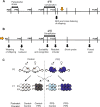Early life adoption shows rearing environment supersedes transgenerational effects of paternal stress on aggressive temperament in the offspring
- PMID: 34657124
- PMCID: PMC8520526
- DOI: 10.1038/s41398-021-01659-2
Early life adoption shows rearing environment supersedes transgenerational effects of paternal stress on aggressive temperament in the offspring
Abstract
Prenatal experience and transgenerational influences are increasingly recognized as critical for defining the socio-emotional system, through the development of social competences and of their underlying neural circuitries. Here, we used an established rat model of social stress resulting from male partner aggression induced by peripubertal (P28-42) exposure to unpredictable fearful experiences. Using this model, we aimed to first, characterize adult emotionality in terms of the breadth of the socio-emotional symptoms and second, to determine the relative impact of prenatal vs postnatal influences. For this purpose, male offspring of pairs comprising a control or a peripubertally stressed male were cross-fostered at birth and tested at adulthood on a series of socio-emotional tests. In the offspring of peripubertally stressed males, the expected antisocial phenotype was observed, as manifested by increased aggression towards a female partner and a threatening intruder, accompanied by lower sociability. This negative outcome was yet accompanied by better social memory as well as enhanced active coping, based on more swimming and longer latency to immobility in the forced swim test, and less immobility in the shock probe test. Furthermore, the cross-fostering manipulation revealed that these adult behaviors were largely influenced by the post- but not the prenatal environment, an observation contrasting with both pre- and postnatal effects on attacks during juvenile play behavior. Adult aggression, other active coping behaviors, and social memory were determined by the predominance at this developmental stage of postnatal over prenatal influences. Together, our data highlight the relative persistence of early life influences.
© 2021. The Author(s).
Conflict of interest statement
The authors declare no competing interests.
Figures




Similar articles
-
Developmental expression of anxiety and depressive behaviours after prenatal predator exposure and early life homecage enhancement.Behav Brain Res. 2018 Jul 2;346:122-136. doi: 10.1016/j.bbr.2017.11.028. Epub 2017 Nov 26. Behav Brain Res. 2018. PMID: 29183765
-
Parental pre-conception stress status and risk for anxiety in rat offspring: specific and sex-dependent maternal and paternal effects.Stress. 2019 Sep;22(5):619-631. doi: 10.1080/10253890.2019.1619075. Epub 2019 May 26. Stress. 2019. PMID: 31131701
-
Paternal environmental enrichment transgenerationally alters affective behavioral and neuroendocrine phenotypes.Psychoneuroendocrinology. 2017 Mar;77:225-235. doi: 10.1016/j.psyneuen.2016.11.013. Epub 2017 Jan 4. Psychoneuroendocrinology. 2017. PMID: 28104556
-
Effects of paternal and peripubertal stress on aggression, anxiety, and metabolic alterations in the lateral septum.Eur Neuropsychopharmacol. 2016 Feb;26(2):357-367. doi: 10.1016/j.euroneuro.2015.11.017. Epub 2015 Nov 30. Eur Neuropsychopharmacol. 2016. PMID: 26776368
-
Animal behavior models. Increased sensitivity to stressors and other environmental experiences after prenatal cocaine exposure.Ann N Y Acad Sci. 1998 Jun 21;846:76-88. Ann N Y Acad Sci. 1998. PMID: 9668399 Review.
References
-
- Yehuda R, Daskalakis NP, Lehrner A, Desarnaud F, Bader HN, Makotkine I, et al. Influences of maternal and paternal PTSD on epigenetic regulation of the glucocorticoid receptor gene in Holocaust survivor offspring. Am J Psychiatry. 2014;171:872–80. doi: 10.1176/appi.ajp.2014.13121571. - DOI - PMC - PubMed
-
- Engmann O, Mansuy IM. Stress and its effects across generations. (Alon Chen) In: Stress resilience: molecular and behavioral aspects. Elsevier; 2019. p. 269–90.
Publication types
MeSH terms
LinkOut - more resources
Full Text Sources

